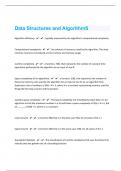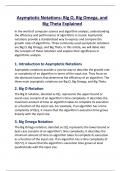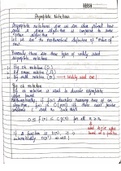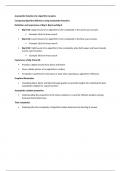Asymptotic notation Study guides, Class notes & Summaries
Looking for the best study guides, study notes and summaries about Asymptotic notation? On this page you'll find 62 study documents about Asymptotic notation.
Page 2 out of 62 results
Sort by

-
Data Structures and Algorithms Wgu - C949|138 Questions with 100% Correct Answers | Updated & Verified
- Exam (elaborations) • 17 pages • 2023
-
- $7.99
- + learn more
Algorithm efficiency - ️️typically measured by the algorithm's computational complexity Computational complexity - ️️the amount of resources used by the algorithm. The most common resources considered are the runtime and memory usage. runtime complexity - ️️a function, T(N), that represents the number of constant time operations performed by the algorithm on an input of size N Space-complexity (of an algorithm) - ️️a function, S(N), that represents the number of fixed-s...

-
WGU C949 - Data Structures And Algorithms QUESTIONS WITH COMPLETE SOLUTIONS
- Exam (elaborations) • 11 pages • 2022
- Available in package deal
-
- $10.99
- 1x sold
- + learn more
WGU C949 - Data Structures And Algorithms QUESTIONS WITH COMPLETE SOLUTIONS Algorithm Describes a sequence of steps to solve a computational problem or perform a calculation. Computational Problem Specifies an input, a question about the input that can be answered using a computer, and the desired output. 00:20 01:45 Longest Common Substring An algorithm that determines the longest common substring that exists in two inputs strings. Binary Search An efficient algorithm...

-
CITS2200 Data Structures & Algorithms Questions with Complete Answers
- Exam (elaborations) • 19 pages • 2024
-
- $12.49
- + learn more
CITS2200 Data Structures & Algorithms Proof by Induction - Answer- Aims to prove correctness for an infinite amount of cases/input. Base case: prove the statement holds true for the smallest possible input/first case. Inductive case: assuming the statement holds true for the n'th case, the statement should hold true for n+1 cases 1) State what it is your trying to prove and prove it is true for the lowest value of n (usually 1) 2) Assume it to be true for P(k) and write that mathemat...

-
CSE 551: Foundations of Algorithms - Arizona State University. CSE 551 Practice Quiz 4 Solutions (2021 Fall)
- Exam (elaborations) • 6 pages • 2023
-
- $8.99
- + learn more
CSE 551 Practice Quiz 4 Solutions Jamison Weber June 1, 2021 Question 1 Solve the following recurrence relation using any method. Provide your answer in big-O notation: T (n) = 2T (n2 ) + 1 for n > 1; 1 otherwise. 1. T (n) = O(n) 2. T (n) = O(n log n) 3. T (n) = O(n2) 4. T (n) = O(log n) Question 2 Determine whether the following statement is true or false and explain your reasoning: The divide-and-conquer approach can be applied to any problem that can be expressed as a linear recurrence rel...
Providing deep summary on the basis of Asymptotic Notations for Algorithm Analysis. Thank you for visiting

-
Time Complexity and Big O Notations & Asymptotic notations
- Other • 10 pages • 2023
-
- $6.49
- + learn more
2 in 1 notes (1) Calculating Asymptotic Time complexity can sometimes be very challenging to understand. This notes throws light on the basics of Time com plexity and Big O notations (2) Explains Big O, Big Omega and Big Theta notations used to analyze Algorithms and Data structure

-
Asymptotic Notations: Big O, Big Omega, and Big Theta Explained
- Summary • 4 pages • 2023
- Available in package deal
-
- $7.99
- + learn more
In the world of computer science and algorithm analysis, understanding the efficiency and performance of algorithms is crucial. Asymptotic notations provide a standardized way to express and compare the growth rates of algorithms. Three commonly used asymptotic notations are Big O, Big Omega, and Big Theta. In this article, we will delve into the concepts of these notations and explore their significance in algorithmic analysis.

-
Asymptotic Notations Big O Big Omega and Big Theta Explained
- Class notes • 3 pages • 2023
- Available in package deal
-
- $10.49
- + learn more
A data structure is a specialized format for organizing, processing, retrieving, and storing data. There are several basic and advanced types of data structures, all designed to arrange data to suit a specific purpose. Data structures make it easy for users to access and work with the data they need in appropriate ways.

-
Asymptotic Notations Notes
- Class notes • 4 pages • 2023
- Available in package deal
-
- $8.49
- + learn more
The definition of an algorithm is that every statement should be an ambitious and it should have a single an exact meaning. Chemistry experiment done by the students in the laboratory gives a procedure and physics experiment done in the lab is also procedure.

-
data structures and computer architecture.system life cyle and algorithms detailed notes
- Class notes • 72 pages • 2023
-
- $8.49
- + learn more
computer data structure engineering notes module 1 System Life Cycle Algorithms Performance Analysis Space Complexity Time Complexity Asymptotic Notation Complexity Calculation of Simple Algorithms

$6.50 for your textbook summary multiplied by 100 fellow students... Do the math: that's a lot of money! Don't be a thief of your own wallet and start uploading yours now. Discover all about earning on Stuvia



